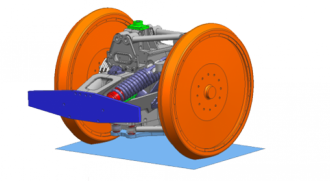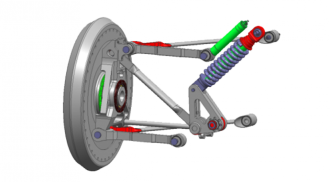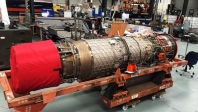The suspension on a car serves three purposes:
- it contributes to good handling and stability making the car safe to drive;
- it protects the vehicle itself from damage and wear;
- it keeps the vehicle’s occupants comfortable, insulating them from bumps and vibrations.
These goals are generally at odds, so the tuning of suspension involves finding the right compromise. In BLOODHOUND the driver is only in the car for a short time and our top priority is to ensure the car is stable throughout the speed range, so we’ve had to compromise on driver comfort to allow for improved stability.
The suspension in BLOODHOUND has to cope with incredible loads when the Car is running at top speeds – up to around 30 tonnes. (That’s like supporting a humpback whale!)
Design
Both the front and rear suspension have a double wishbone layout, similar to a Formula 1 car, as this gives the best suspension stiffness. This in turn prevents the wheels from flexing off line, which can cause instability.
The front track is 1 metre and the rear is 2.39 meters, which gives a compromise between vehicle lateral stability, aerodynamic drag, the ability to get a working suspension layout packaged in the car and camber and toe stiffness.
Front suspension
 The front suspension sub assembly is nicknamed ‘the goat’s head’, simply because that’s what it looked like on the engineering drawings produced using computerised stress analysis. It’s almost certainly the hardest-working land-based vehicle suspension component in history, being designed to take over 30 tonnes.
The front suspension sub assembly is nicknamed ‘the goat’s head’, simply because that’s what it looked like on the engineering drawings produced using computerised stress analysis. It’s almost certainly the hardest-working land-based vehicle suspension component in history, being designed to take over 30 tonnes.
The Goat's head
It’s made of four huge five-axis machinings that are made from 7075 forgings (7075 being the specific alloy and forged parts being used for greatest strength and therefore control of residual stresses). These were forged multiple times to shape the grain to maximise the strength of the metal. The upper parts had a start weight of 313kg each but finished up weighing just 18kg each – that’s 94% of the metal removed. The lower two parts started at 149kg each and had 89% of the metal removed, ending up at 16kg each. Add all this together and the total start weight for the whole assembly was 924kg – yet the four parts of the assembly together now weigh just 68kg.
In addition to these four main parts, there are 268 other bespoke components that make up the main front assembly.
Rear suspension
 The rear suspension sub-assembly is a huge and complex structure that has to take all of the load from the rear wheels, plus the rocket thrust, at the back end of the Car.
The rear suspension sub-assembly is a huge and complex structure that has to take all of the load from the rear wheels, plus the rocket thrust, at the back end of the Car.
Solid billets of aluminium weighing around 2.5 tonnes were carefully machined into 196kg of precision-made components in a process that took over a year. Overall, this set of parts makes up about 10% of the Car’s primary structure.
Springs
Car suspension relies on springs and BLOODHOUND is no different. We have a range of springs to choose from, so that we can change them should the initial run data show that this would be beneficial. The springs we plan to use initially are around 10 times stiffer than those on a standard family car, at about 150N/mm on the front and 240N/mm on the back. (This measurement shows how much force is needed to compress a spring by 1mm.)
Dampers
Dampers – otherwise known as shock absorbers – are vital for smoothing the movement of the suspension. In this case, we’re still using the same simple technological solution that has been used for around 100 years, which is basically a piston in hydraulic oil. The drag on the piston slows down the movement, helping to absorb any shock.
Further reading
You can read more about:
- the manufacture of the front suspension subassembly in Conor La Grue’s May 2014 blog
- the suspension pull rods in Andy Green’s July 2014 diary .


